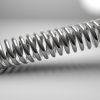Magnetic Field Diode
The future of electronics may change, as researchers have created a material that acts as a magnetic diode. This “magnetic field diode” is similar to the already known electrical diode, but this device could transfer a magnetic field to another object, but not the other way around.
This magnetic field diode has been successfully demonstrated by head author Jordi Prat-Camps—a University of Sussex researcher—and colleagues at the University of Innsbruck in Austria, along with theorist Oriol Romero-Isart and experimental physicist Gerhard Kirchmair from the Institute for Quantum Optics and Quantum Information (IQOQI),
Electrical Diodes and Lorentz Reciprocity Principle
Electric diodes have long been used as fundamental components in electronics. Simply put, electric diodes allow currents from a wire coil, for example, to flow in one direction to another coil, but not vice versa. Engineers have long wanted a comparable device that would involve magnetic fields versus electric currents. This was never possible due to the Lorentz Reciprocity Principle, which states when a magnetic field source, such as a wire coil, induces a field in a second source, the second source will be able to induce a field in the first. So, thanks to the laws of electromagnetism—and experimental demonstrations to date—this transfer is symmetric, meaning the fields move both from A to B and B to A.
While electrical diodes can solve this problem, there hasn’t been an equal solution when dealing with magnetic fields. That is until research Prat-Camps and his team came in with the magnetic field diode.
How Does It Work?
This magnetic field diode works similarly to an electrical diode, but with the addition of a few items. In order for the magnetic field to not work symmetrically, the two coils must be placed in the walls of a hollow, conducting cylinder. You can’t just add a cylinder though, as the cylinder must rotate at a constant velocity. The cylinder acts as a cloak that makes objects invisible to the magnetic field/is a “wormhole” that directs a magnetic field between two points in space along an invisible tunnel, as well as other things. The nonreciprocity of the magnetic field will then hold as long as the cylinder keeps spinning at the constant velocity.
This new diode could be used in a wide range of applications in electrical devices that currently use symmetrically-coupled magnetic elements, including electric motors, transformers, and MRI machines. In addition, wireless chargers can be greatly improved with this technology—you want energy flow in one direction (to the phone from the charger) and not the other way around (to the charger from the phone).
While the magnetic field diode is currently too bulky to be practical in everyday use, researchers believe this was a monumental first step. With more research, we may be seeing magnetic field diodes in a lot more of our electronics. This work was financially supported by the Austrian Ministry of Education, Science, and Research and the European Union and published in the journal Physical Review Letters.
LEARN MORE
For more information on break-through magnetic discoveries, browse through our magnet in the news section or subscribe to our monthly newsletter.

